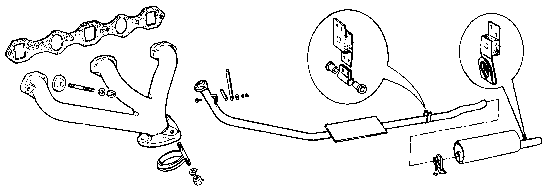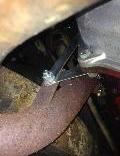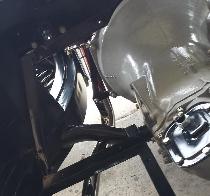The MGA With An Attitude
EXHAUST SYSTEM, General Information -- EX-101
It's funny that the MGA exhaust system is hardly mentioned in the Workshop Manual. Maybe they thought the stock exhaust was a no-maintenance item, just replace parts that fail or break (not far from the truth). Your best reference then might be the factory Service Parts List, or on the cheap, just a vendor parts catalog.

The flat rectangle near the center of the diagram is not part of the pipe. That is an insulated heat shield to be attached under the plywood floor. The stock exhaust pipe is (was) one long piece running from the iron manifold back to the muffler. Replacement pipes are commonly supplied in two pieces with a slip joint and clamp in the middle to facilitate shipping.
The original type muffler is, in general, a round metal can with a pipe "apparently" running through it off center. Internally the original muffler may have had metal baffles, or may have been a glass pack. Many replacement mufflers are "glass packs", having a simple perforated straight through pipe and being packed with high density fiberglass wool. The muffler should be positioned with the inlet and outlet pipes at the lowest point, and the round body standing highest upward for the greatest ground clearance and roughly equal spacing on either side. If it is rotated left or right it may hit the leaf spring or the fuel tank. The outlet pipe (in original form) has a slight bend to bring the outlet tip higher and to the right to clear the bumper overrider. Properly positioned the tip should be pointing approximately two o'clock.
This is the correct original configuration with the outlet pipe near to the underside of the bumper and near the overrider and pointing slightly upward, and it all functions well. If the muffler is turned to have the outlet pipe pointing down or slightly to the left, like 6 to 8 o'clock position, this can cause exhaust smell in the cockpit while driving, which is probably not good for your health.
There are two metal/rubber hangers at center and back. The exhaust system runs hot in a "hostile" environment, so the rubber isolators eventually deteriorate and break, and the metal hangers and bolts tend to rust. By fortunate good design there are no captive threads in the frame, and it's all held together with separate nuts and bolts. So when it needs to be disassembled, and the fasteners might be badly rusted, just break the bolts and install new ones. The stock type hangers are relatively simple, inexpensive and expendable parts.
Near the front of the main pipe there is a welded bracket on the pipe, and a pair of short
 metal flat straps with holes at the ends. These are intended to hang and brace the pipe to the gearbox bellhousing bolts so the pipe will be one with the engine when it shakes and will not stress the sealing gasket joint (and bolts) between the pipe and the iron manifold. This good theory is not well executed in the real world. Quite often the bracket welded on the pipe is not exactly at the correct height, and/or the longer strap may not be the correct length. In any case the longer strap has no significant strength in compression, so the short strap ends up doing all the work.
metal flat straps with holes at the ends. These are intended to hang and brace the pipe to the gearbox bellhousing bolts so the pipe will be one with the engine when it shakes and will not stress the sealing gasket joint (and bolts) between the pipe and the iron manifold. This good theory is not well executed in the real world. Quite often the bracket welded on the pipe is not exactly at the correct height, and/or the longer strap may not be the correct length. In any case the longer strap has no significant strength in compression, so the short strap ends up doing all the work.
 Not to worry, as the bolted flange joint at the manifold is quite strong Not to worry, as the bolted flange joint at the manifold is quite strong
 in the vertical direction, so you can simply omit the longer strap. Lateral vibration can be quite harsh, so the shorter horizontal strap is important. Unfortunately it is not particularly strong and may commonly crack and break. By long experience I can say a simple solution is to double up on this shorter horizontal strap. If you ever manage to break the double thickness strap, then fabricate one from thicker metal, good for a life time.
in the vertical direction, so you can simply omit the longer strap. Lateral vibration can be quite harsh, so the shorter horizontal strap is important. Unfortunately it is not particularly strong and may commonly crack and break. By long experience I can say a simple solution is to double up on this shorter horizontal strap. If you ever manage to break the double thickness strap, then fabricate one from thicker metal, good for a life time.
The donut shape sealing ring between the pipe flange and the iron manifold will most often have a metal cover on one side and uncovered fiber surface on the other side. This begs the question, which side up? I don't suppose it makes much difference either way. I wouldn't get into any argument about it, but John Twist recommends mating the fiber side to the iron manifold and the metal side against the pipe flange.
Repairing stripped or broken studs in the manifold will be covered in another article. Otherwise a well made stock type exhaust system is usually easy enough to bolt in place with not much fuss. Be sure to get the complete set of clamps and hangers as original, and also the related bolts and washers and nuts if you can. This is important for your home installation to save time and avoid delays for re-orders. It is equally important if you are having a pro shop install the system. If there are missing hangers the installation shop may be jury rigging hangers with odd parts that may not work as well as they should. Similarly off the shelf standard pipes are usually a nice fit, but a pro shop trying to bend a pipe to fit may have less desirable results.
At the front flange joint the original fasteners should be threaded steel studs, helical spring lockwashers, and brass hex nuts. When mild steel nuts are used through error or negligence, they tend to rust badly. End result at time of next disassembly would be rounded off corners, seized threads, and possibly stripped or broken studs. If you encounter this problem you might try to split the nut for removal, as damaged studs can be difficult to replace, and a broken flange on the iron manifold can be VERY difficult to repair.
The spring steel lockwashers tend to lose spring temper with heat cycling. They may serve the purpose long enough for mild steel nuts to rust in place, but when used with brass nuts the lockwasher may fail and allow the nuts to vibrate loose. Original brass nuts were standard form and relatively weak in the threads, so it is all too easy to strip the threads out of the nut when trying to get it tight enough not to fall off. A better part is an extra tall brass nut, more expensive but less likely to strip out the thread. Even then the brass nut may still vibrate loose as the lockwasher fails with heat cycling.
Another method is to forget about the lockwasher and double nut the joint. Unless special length studs are used, two long nuts will most likely not fit on the (too short) stud. Using two standard form brass nuts you are back to the problem of possibly stripping the threads, and I have known the brass nuts to still vibrate loose in spite of being double nutted. The best solution I have found is to double nut it using stainless steel nuts. You can make them tight so it will not vibrate loose (usually), and they do not rust so they can be removed later.
|